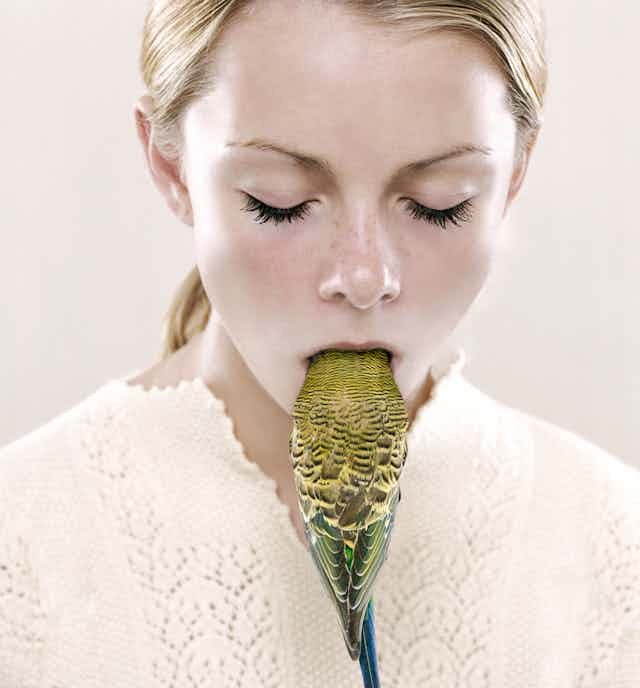Human-bird interaction, (both the good and the bad), is a dominant theme amid the 70 artworks in Birds: Flight Paths in Australian Art. This review explores the exhibition from an ecologist’s mindset.
Its feature artwork, Shenae & Jade by Petrina Hicks, is a close-up of a budgie stuffed into a young woman’s mouth. Reactions to the image that we overheard ranged from “somewhat erotic” to “is she throwing up the budgie?” to “that’s just animal cruelty!”

According to the artist, this image actually demonstrates a strong bond between the human owner and her pet bird. And strange though it might seem, this isn’t the first bird to find it completely natural to climb into a person’s mouth. Grainne’s pet cockatiel will put one leg on her bottom lip and try to prise her mouth open. When Grainne does give in to her dear bird’s demands it enjoys picking food from her teeth …
Other works on show include Claudia Terstappen’s road kill photographs, in which dead birds, shown in characteristic poses, are displayed on a deliberately ambiguous black backdrop (which could be a road). They feature iconic Australian species, the kookaburra and sulphur-crested cockatoo, perhaps to have the biggest impact.
While these images clearly demonstrate the risks our city birds face, both the kookaburra and the cockatoo actually do well in the urban environment, so much so that we’d call them urban adapters. Why not celebrate the success of these birds as champions in their ability to adapt to the sometimes harsh conditions of city life?
Another image, Dying Flying by Tony Coleing, seems to capture a bird in flight. It is a very striking and beautiful picture on first glance – until you realise the bird is dead! As we speculate how the little thing met its demise, another question comes to mind. How will the transformation of natural habitat affect birds long-term?

Still, while this image shows the loss of one small bird, others are adapting well and living alongside us. Take the superb fairy-wren, a species that can become very tolerant and tame around humans, often feeding and nesting close to houses and human activity.
Lunch with the Birds by Jill Orr is a series of wacky photos of a woman covered in bread and fish, which aims to instigate a human-bird interaction. Apparently, the artist intended to provide a banquet for the seagulls and to test their courage in dining off her body as if it were a kitchen table.
The photographs show a distinct lack of interest from the seagulls. This may be because she provided the wrong food. Or it may be because they’re too intelligent to dine off a corpse-like body lying on St Kilda beach.

A strong theme from the artwork on display is that of a human fascination with birds that has existed for hundreds of years. Ginger Riley Munduwalawala depicts Ngak Ngak (the white-breasted sea eagle) as a guardian of country. Dreamtime stories describe our duty to birds, to live at one with them.
The exhibition provides clear examples of this not happening; a lack of guardianship as it were. But some pieces do portray the enduringly positive connection we have with our feathered friends, as in the bird statues made by local kids out of recycled materials.

Some ridiculous, gaudy works make us reflect on aspects of human nature, like the desire to constantly improve or embellish what is naturally beautiful. Take Kate Rohde’s piece Falcon and Chinchillas for example, in which a falcon is adorned in purple and gold and surrounded by fake flowers. And in Galah (Wild Ribbons Instead of Sleep), a taxidermy galah looks ridiculous in its striped outfit … complete with bobble.
These pieces are in sharp contrast to some of the more traditional artworks on display which accurately represent our bird species, such as that of the Gang Gang Cockatoo – full of character, just like the real-life counterpart.
Our favourite piece, Jack and Errol – Melbourne Museum Bower Birds by Penny Byrne, is a lovely example of a positive human-bird interaction. The art represents a collector’s treasure trove of items found littering the streets of inner city Melbourne. Acting like a bowerbird, Byrne gathered all manner of rubbish from badges to bottle tops to playing cards and encased them in a glass dome around a pair of porcelain birds.

Satin bowerbirds have been found to do quite well in urban gardens where they will take blue pegs and bottle tops to adorn their bowers. Byrne’s work is a reflection on this behaviour in relation to her own human habits. She, like the bowerbird, has proudly displayed her own collection of found treasures, and in doing so shows us a part of her own identity, just as the bowerbird does. You go sister!
While it is true that many birds are at risk from climate change, deforestation and habitat loss, some birds are also adapting to urban environments. These birds are learning to live with us for their own survival and will make a home in our back gardens. As we were leaving the exhibition we saw a flock of galahs, an eastern rosella and a family of fairy wrens hopping around a bit of scrub. We are all well aware of the threats facing our birds, but let’s not forget to open our eyes and celebrate the true Aussie battlers that are our urban birds.
Birds: Flight paths in Australian Art at Art Mornington Peninsula Regional Gallery closes on 12 February 2017.

